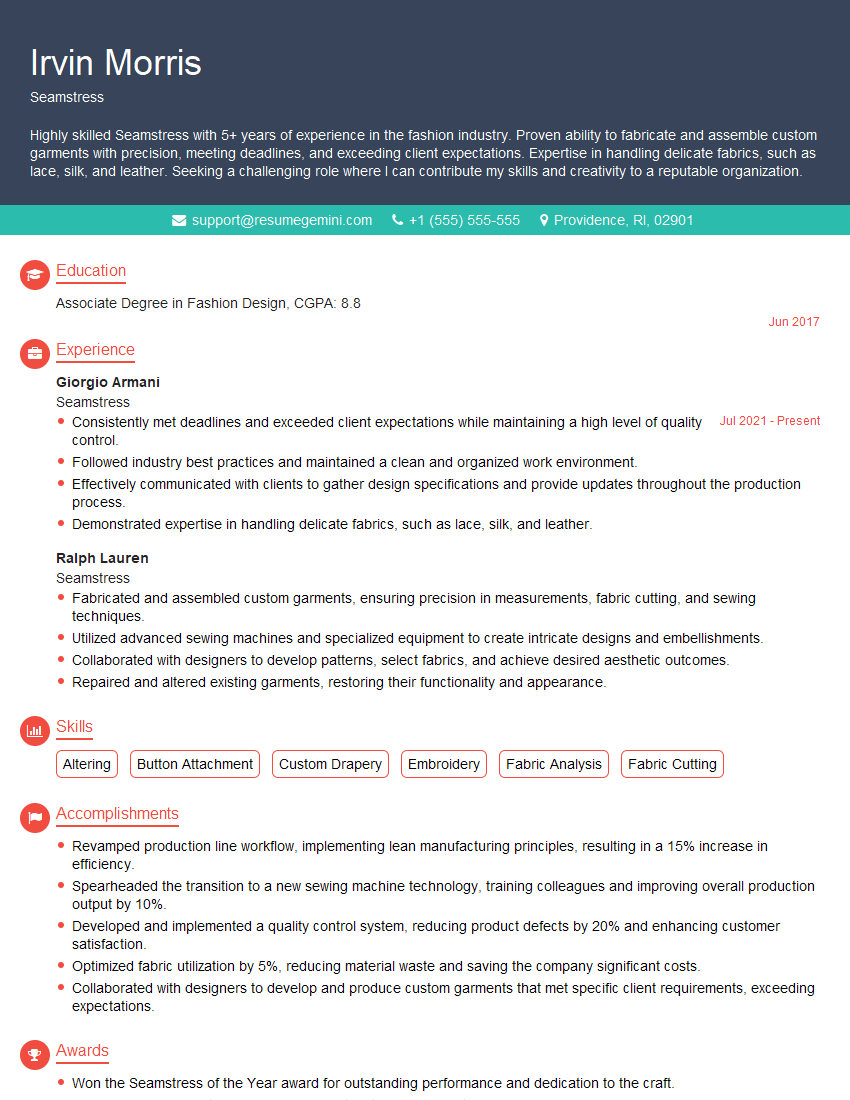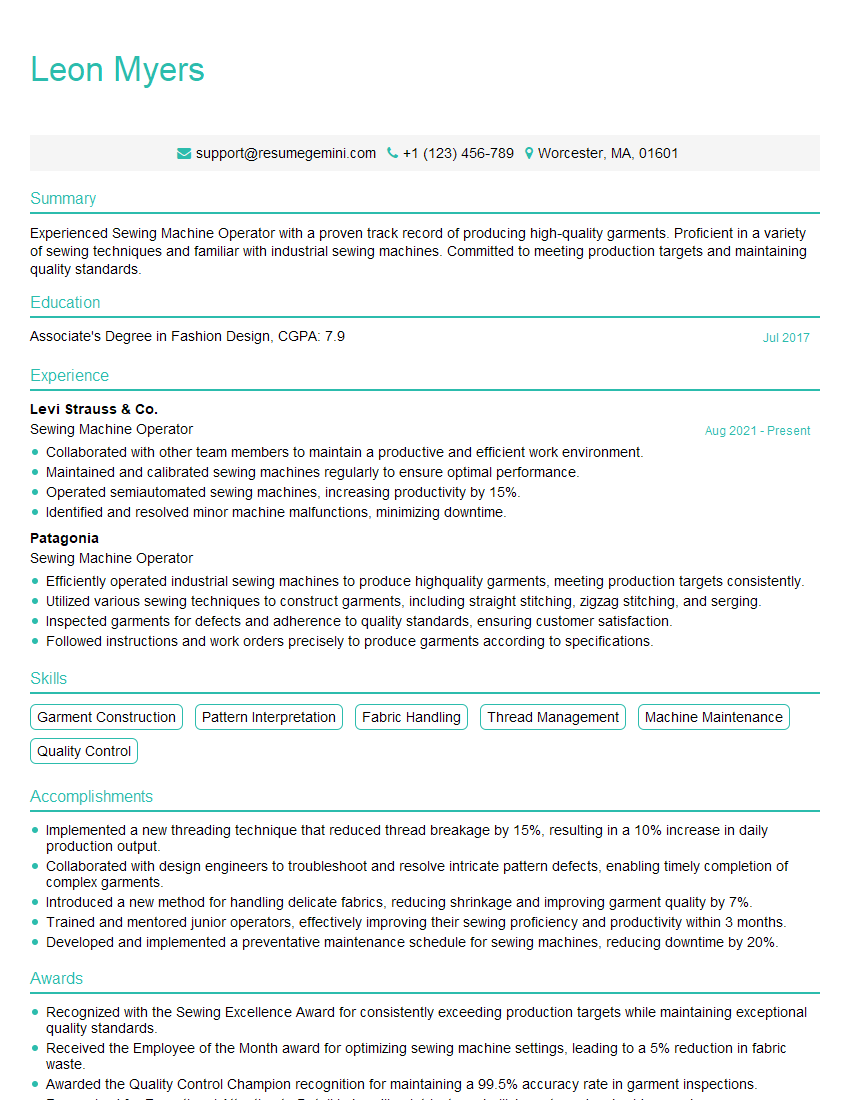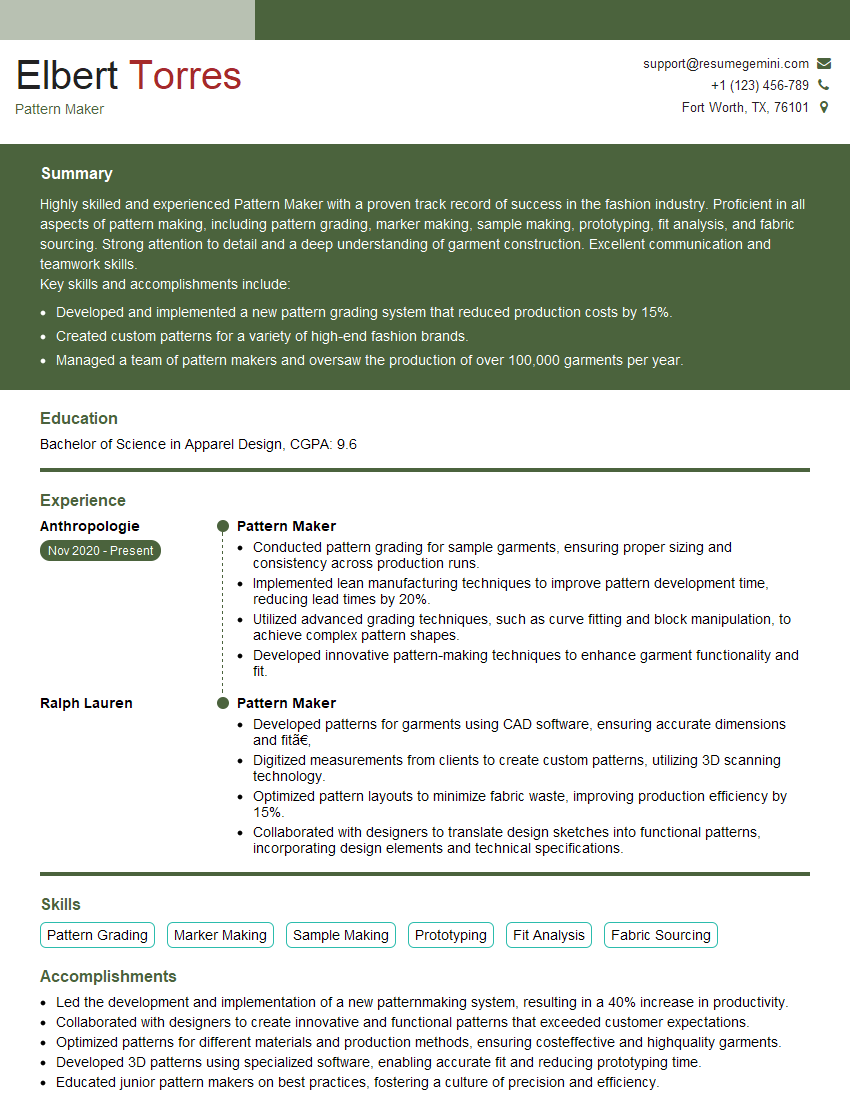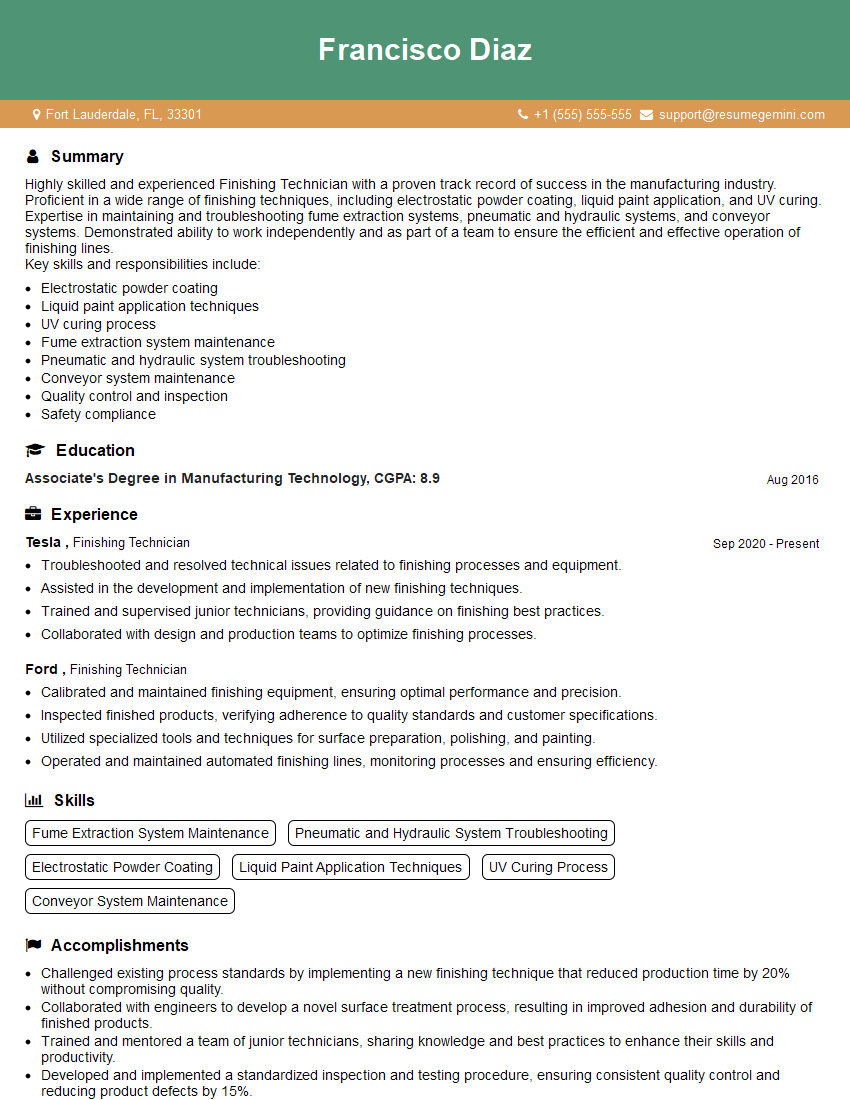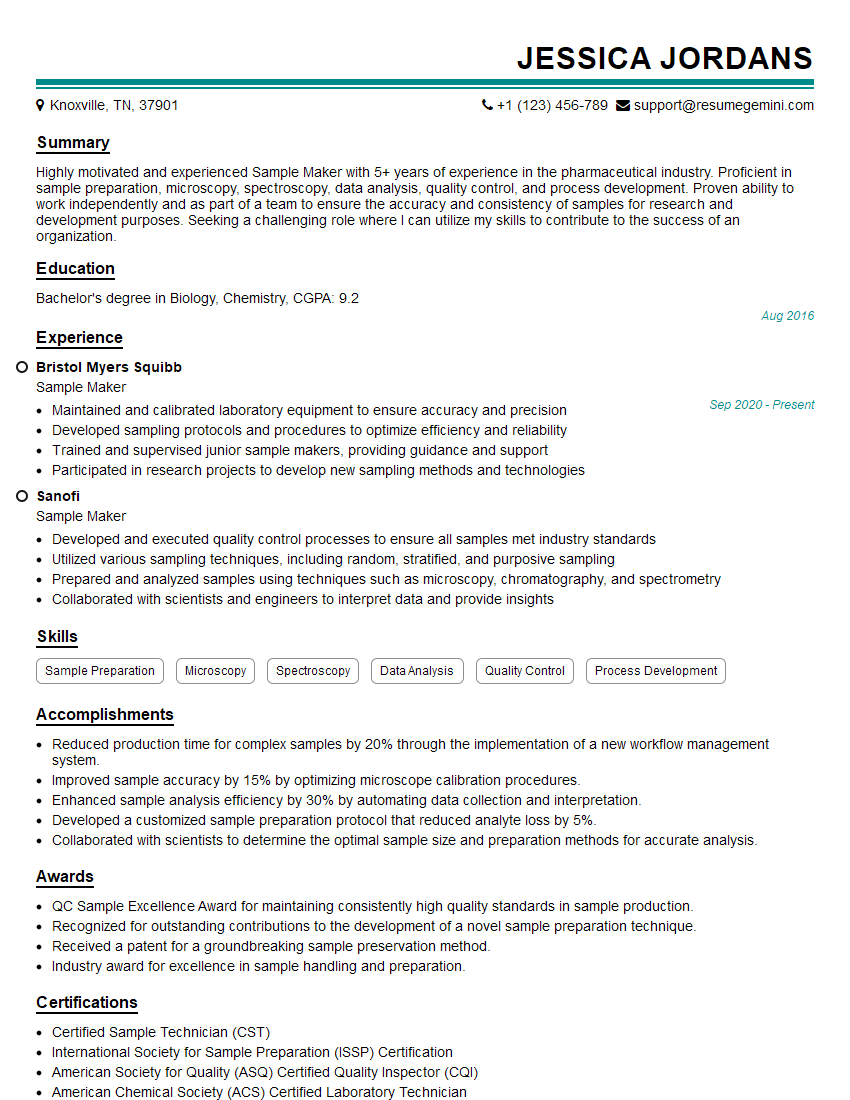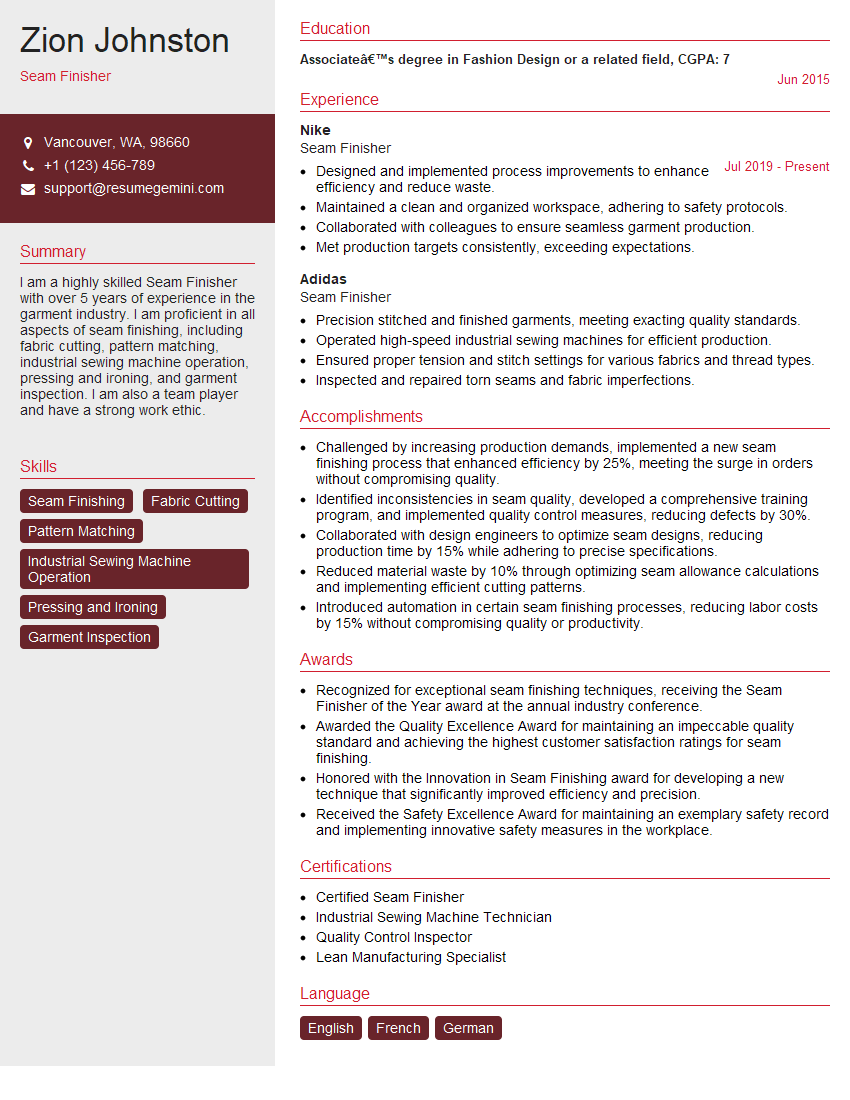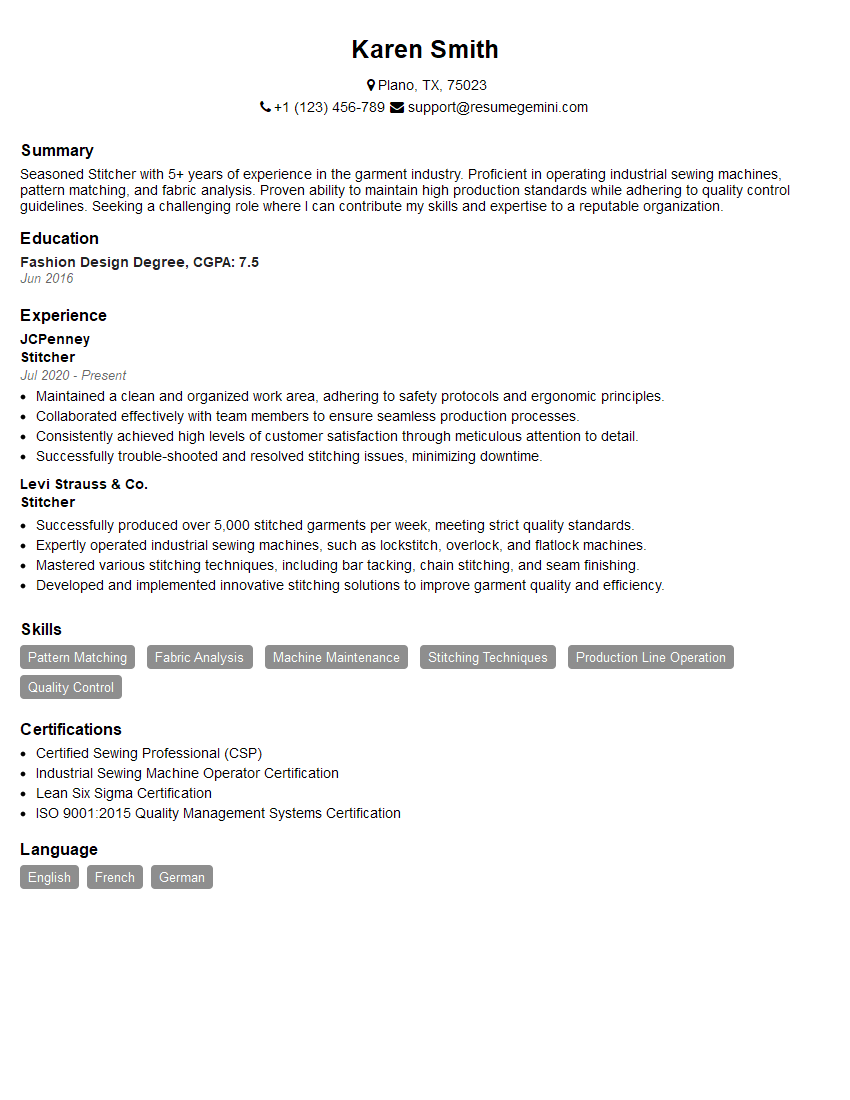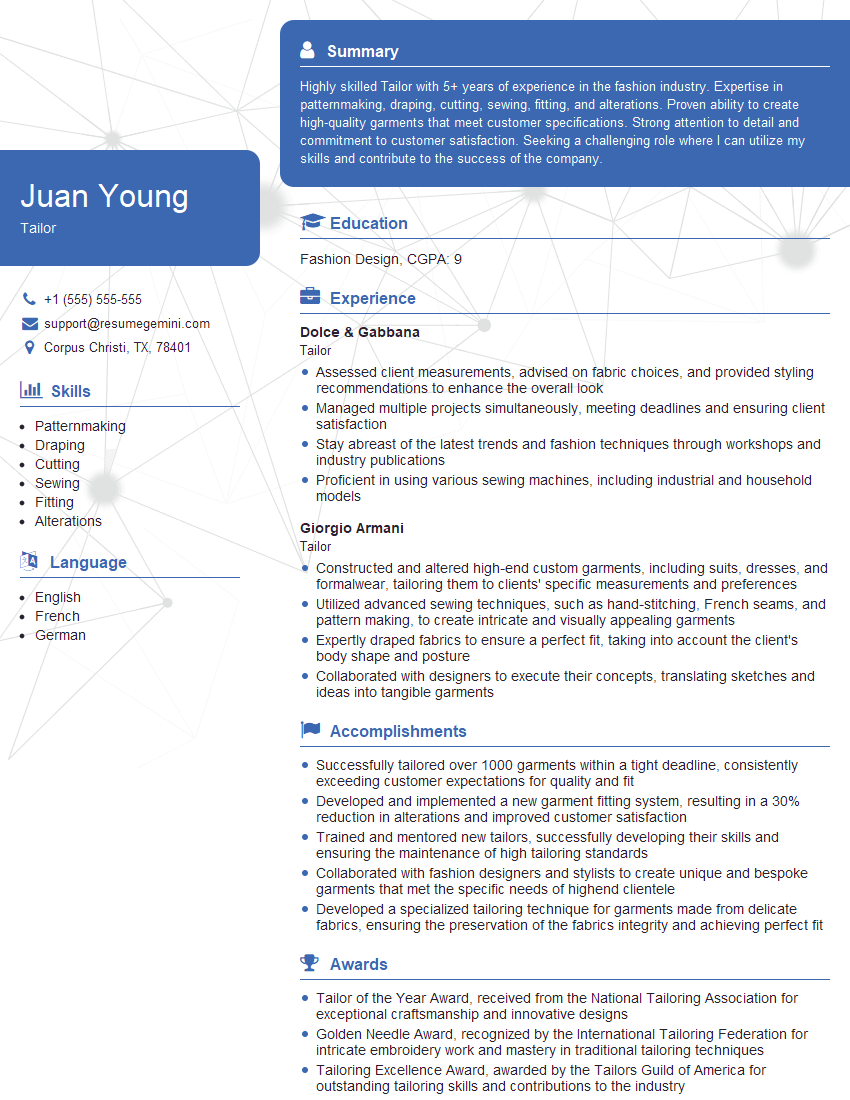Every successful interview starts with knowing what to expect. In this blog, we’ll take you through the top Stitching and Seam Finishing interview questions, breaking them down with expert tips to help you deliver impactful answers. Step into your next interview fully prepared and ready to succeed.
Questions Asked in Stitching and Seam Finishing Interview
Q 1. Explain the difference between a French seam and a serged seam.
Both French seams and serged seams are excellent methods for finishing seams, but they differ significantly in technique and resulting appearance. A French seam encloses the raw edges completely, creating a very neat and professional finish, particularly suitable for fine fabrics where you want a clean, invisible seam. It involves sewing the seam allowance twice, the first time with wrong sides together, and the second time with right sides together, effectively enclosing all raw edges. Think of it like a perfectly wrapped present—all the messy bits are tucked away inside.
A serged seam, on the other hand, uses a serger (overlock machine) to simultaneously sew and finish the seam edge in one step. The serger cuts and overlocks the seam allowance, creating a durable, stretchy finish that prevents fraying. This is ideal for stretchy fabrics and where durability is key. Imagine it as a neatly trimmed and reinforced edge; sturdy and quick.
In short: French seams are elegant and precise; serged seams are robust and efficient.
Q 2. Describe three methods for finishing a raw edge.
Three popular methods for finishing raw edges are:
- Zigzag stitch: A simple and widely used method where a zigzag stitch is sewn along the raw edge, preventing fraying. It’s quick and easy, but the finish can be bulky on heavier fabrics.
- Pinking shears: These shears create a serrated edge, reducing fraying by creating interlocking fibers. This method is straightforward and quick, suitable for less visible seams or lightweight fabrics. It’s like giving the edge a miniature haircut that prevents it from unraveling.
- Overlocking/Serging: A serger trims and stitches the edge simultaneously, creating a professional, neat, and highly durable finish. It’s best for stretchy fabrics and projects that demand durability. It’s the equivalent of a carefully sewn and bound edge—strong and secure.
Q 3. What types of seam finishes are best suited for stretchy fabrics?
For stretchy fabrics, seam finishes that maintain flexibility and prevent unraveling are crucial. The best choices include:
- Serging/Overlocking: This method is the gold standard for stretchy materials as it stretches with the fabric without restricting movement.
- Zigzag stitch: A wide, slightly looser zigzag stitch can provide a stretchy finish, but it’s less durable than serging. You might need to adjust the stitch width and length depending on the fabric’s stretch.
- Narrow rolled hem: Using a specialized sewing machine foot, you can roll and stitch very narrow edges, creating a neat and flexible finish for lightweight stretchy fabrics.
Avoid methods that create stiff seams, like French seams, on highly stretchy fabrics as they can restrict movement and cause stress points.
Q 4. How do you prevent puckering when sewing curved seams?
Puckering on curved seams is a common problem, often caused by uneven tension or stretching of the fabric. Here’s how to prevent it:
- Clip curves: Carefully clip into the seam allowance of convex curves (curves that curve outward) to allow the fabric to lie flat. Do not clip into the stitching line!
- Use a smaller stitch length: A shorter stitch length provides more control and helps prevent the fabric from stretching unevenly.
- Grade seam allowances: Trim the seam allowances to varying widths, making the lower layer slightly narrower than the top. This reduces bulk and helps the fabric to lie flat.
- Use a walking foot: A walking foot helps feed both layers of fabric evenly, especially beneficial for thicker or slippery fabrics.
- Understitch: For certain applications, understitching (stitching the seam allowance to the facing) will prevent the seam allowance from rolling to the outside, creating a cleaner and smoother seam.
Remember, practice makes perfect! Experiment with these techniques to find the best method for different fabric types and curve complexities.
Q 5. What are the advantages and disadvantages of using a zigzag stitch for seam finishing?
A zigzag stitch is a quick and readily available method for seam finishing, but it has both advantages and disadvantages:
- Advantages: Simple, fast, prevents fraying, readily available on most sewing machines.
- Disadvantages: Can be bulky, especially on thicker fabrics; not as strong or durable as serging; prone to showing on the right side of the fabric, especially with a visible stitch.
For instance, a zigzag stitch is perfectly acceptable for a quick home project on a lightweight cotton, but might be insufficient for a garment meant for strenuous activity or when a perfectly flat, invisible seam is needed.
Q 6. Explain the importance of proper seam allowance.
Proper seam allowance is crucial for several reasons:
- Consistent Fit: A consistent seam allowance ensures accurate garment construction and a precise fit. Inconsistent seam allowances lead to ill-fitting garments.
- Ease of Construction: A standard seam allowance makes pattern matching, sewing, and pressing easier and more predictable.
- Structural Integrity: Sufficient seam allowance provides strength and durability to the garment, preventing seams from tearing or ripping.
- Professional Finish: Adhering to a standard seam allowance creates a clean and professional look. Varying seam allowances appear sloppy.
For example, a 5/8 inch seam allowance is a common standard in many sewing patterns. Maintaining this consistency throughout the project is key to a well-made garment.
Q 7. How do you identify and repair common stitching errors?
Identifying and repairing stitching errors requires careful observation and attention to detail. Here are some common errors and their solutions:
- Skipped stitches: These are usually visible as gaps in the seam. Solutions include re-sewing the section with a reinforcing stitch or using a seam ripper to carefully remove the faulty area and resewing.
- Uneven stitches: Uneven stitches indicate inconsistent tension on the machine. Check your machine’s tension settings and possibly try a test run on a scrap piece of fabric.
- Puckered seams: This is often caused by uneven fabric feeding or stretching. Solutions include carefully clipping curves, grading seam allowances, and using a walking foot.
- Broken needles: A broken needle can lead to skipped stitches and fabric damage. Replace broken needles immediately and always use the correct needle type for the fabric you are sewing.
Always carefully examine your work as you go and don’t hesitate to rip out and redo sections with errors. This will save you time and frustration in the long run.
Q 8. What are some common problems encountered when sewing with different fabric weights?
Sewing with different fabric weights presents unique challenges. Lighter fabrics like silk can be easily damaged by improper needle selection or tension, while heavier fabrics like denim require more powerful machines and potentially different needles to prevent breakage.
- Needle Selection: Using the wrong needle size can lead to skipped stitches (too thick a needle for fine fabric) or broken needles (too thin a needle for heavy fabric). For example, a fine silk needs a very fine needle (size 60/8), while denim might need a heavier-duty needle (size 16/100).
- Stitch Length: Shorter stitches are generally needed for lighter fabrics to prevent skipped stitches and for added strength. Longer stitches are preferable for heavier fabrics for easier feeding through the machine.
- Presser Foot Pressure: Too much pressure on lighter fabrics can cause puckering or distortion; too little pressure on heavier fabrics can lead to uneven feeding. Adjust your presser foot accordingly; many machines have adjustable pressure settings.
- Seam Allowance: Consider increasing seam allowances slightly with stretchy fabrics to account for stretch during wear.
- Seam Finishing: Appropriate seam finishes are crucial, preventing fraying and preserving the integrity of the fabric. Lighter fabrics may require delicate finishes like rolled hems or serging, while heavier fabrics might handle a simple zigzag stitch or pinking.
For instance, when sewing a silk blouse, I use a very fine needle, a shorter stitch length, lower presser foot pressure, and a delicate serged seam finish. When sewing a pair of denim jeans, I’d opt for a heavier-duty needle, a longer stitch length, slightly increased presser foot pressure, and a simple zigzag or even a durable topstitching for finishing.
Q 9. Describe your experience with various sewing machine types.
My experience encompasses a wide range of sewing machine types, from basic mechanical machines to advanced computerized models. I’ve worked with both industrial and domestic machines. My proficiency extends to understanding their unique capabilities and limitations.
- Mechanical Machines: These offer a great foundation for understanding stitch mechanics and developing fundamental sewing skills. Their simplicity makes troubleshooting relatively straightforward.
- Computerized Machines: These offer programmable stitch patterns, automatic features like buttonhole stitching, and adjustable settings for various fabrics. The sophisticated controls allow for intricate projects with greater precision.
- Industrial Machines: I have experience operating industrial machines, specifically for specialized tasks such as lockstitching, overlocking, and blindstitching. These machines are powerful and built for high-volume production, requiring a different skill set related to speed and efficiency.
Each machine type demands a specific approach; for example, while a computerized machine may automate tasks, it’s crucial to understand its limitations and fine-tune settings for optimal results, whereas a mechanical machine’s adjustments require hands-on familiarity to master.
Q 10. How do you maintain your sewing machine to ensure optimal performance?
Regular maintenance is paramount for ensuring optimal sewing machine performance. This involves a proactive approach that goes beyond occasional cleaning.
- Daily Cleaning: After each sewing session, I remove lint and thread clippings from the bobbin area, around the needle plate, and under the feed dogs. This prevents build-up that can hinder smooth operation.
- Regular Oiling: Depending on the machine’s manual, I use the appropriate sewing machine oil sparingly on moving parts. Over-oiling can be detrimental. I avoid oiling the motor.
- Periodic Inspection: I regularly check the needle for bends or damage. I also inspect the timing of the feed dogs and needle bar for proper synchronization.
- Professional Servicing: I recommend professional servicing at least annually. A qualified technician can perform a thorough inspection, adjust internal mechanisms, and address any issues before they become major problems.
Neglecting maintenance can lead to stitch inconsistencies, skipped stitches, and even machine breakdown. A well-maintained machine produces high-quality results and extends the machine’s lifespan, saving time and money in the long run.
Q 11. What is your preferred method for pressing seams?
My preferred method for pressing seams involves using a tailor’s clapper. This is a heat-resistant, flat tool that helps set the seams flat and crisp and prevents wrinkles.
- Correct Temperature: I always set the iron to an appropriate temperature for the fabric type, using a test patch beforehand.
- Pressing, Not Ironing: Instead of sliding the iron across the fabric (ironing), I use a gentle pressing motion, applying pressure for a few seconds then lifting the iron. This prevents shiny marks on the fabric.
- Use of Clapper: After pressing, I place the clapper on the seam to help flatten and cool the fabric, setting the shape.
- Pressing Cloths: For delicate fabrics, I always use a pressing cloth to protect the material from direct heat.
This technique ensures clean, professional-looking seams and contributes significantly to the overall quality of the garment.
Q 12. How do you ensure consistent stitch length and tension?
Consistent stitch length and tension are vital for producing high-quality work. Achieving this involves a combination of machine adjustment and proper technique.
- Machine Adjustment: The stitch length is controlled by the dial on the machine (or digitally on computerized models). I carefully adjust this setting based on the fabric weight and project. The tension control dial adjusts the upper and lower thread tension. Proper balancing is key.
- Test Stitching: I always test my settings on a scrap of the same fabric before starting the actual project. This allows me to make adjustments to achieve even stitching.
- Proper Threading: Ensuring correct threading of the machine is crucial, as improper threading can lead to tension issues.
- Needle and Thread: Using the correct needle and thread combination for the fabric plays a crucial role in tension consistency.
For example, if stitches are bunching up, I might slightly reduce the upper tension. If they are loose, I might increase the tension. It’s often a process of fine-tuning to achieve the perfect balance.
Q 13. Explain your experience with different types of needles and threads.
Selecting the correct needles and threads is critical for successful sewing. Different fabrics require different needle types and thread weights.
- Needles: I use various needle types such as sharp needles for woven fabrics, ballpoint needles for knits, and microtex or embroidery needles for fine fabrics like silk. The needle size is also crucial, ranging from very fine for silk to heavy-duty needles for denim.
- Threads: Thread selection depends on the fabric and the project. Cotton thread is versatile, while polyester thread is stronger and more durable. Silk thread is ideal for delicate fabrics. I choose thread weights that are appropriate for the needle size and fabric.
For example, when sewing silk, I’d use a fine microtex needle and a fine silk thread. Sewing denim would require a heavier-duty needle and strong polyester or cotton thread.
Q 14. How do you handle different types of fabrics, such as silk, denim, and leather?
Handling different fabric types requires adjusting techniques and settings to achieve optimal results.
- Silk: Silk is delicate and requires a fine needle, a slow sewing speed, and a light touch. I use a walking foot or a specialized presser foot for even feeding. Seam finishes are typically delicate, like rolled hems.
- Denim: Denim is a heavy-duty fabric that requires a heavier-duty needle and a longer stitch length. I might use a jeans needle, designed to handle the thick fibers. Pressing is important to set the seams, but too much pressure can create impressions on the surface of the fabric. Durable seam finishes, like zigzag or serging are appropriate.
- Leather: Leather requires specialized needles and thread. A leather needle has a rounded tip to avoid puncturing the material. I may use heavy-duty thread or even waxed thread for durability. A walking foot is often helpful to feed the leather smoothly through the machine. Because leather doesn’t fray, seam finishing might be minimal or even decorative stitching.
Adapting techniques and tools based on the fabric’s properties is a crucial skill that contributes to the quality of the final product. Each fabric has its unique nuances, and I tailor my approach accordingly to achieve the desired outcome.
Q 15. Describe your process for constructing a garment from a pattern.
Constructing a garment from a pattern is a meticulous process that involves several key steps. First, I carefully study the pattern pieces, noting grainlines, notches, and markings. Then, I choose the fabric, considering its drape, weight, and suitability for the garment’s style. Next, I meticulously cut the pattern pieces, ensuring accurate placement and alignment on the fabric, taking into account the fabric’s nap or directional prints. After cutting, I carefully mark all notches and pattern markings onto the fabric using tailor’s chalk or a fabric marker. The next stage involves assembling the garment, following the pattern’s instructions. This includes stitching seams, pressing them open or to one side, and finishing the raw edges to prevent fraying. Finally, I check the garment for any imperfections and make adjustments as needed before the final pressing and finishing.
For instance, when constructing a tailored shirt, I would pay extra attention to the precise placement of the collar and cuffs, ensuring a clean and crisp finish. On a more casual garment like a pair of trousers, I would prioritize ease of movement and comfort, ensuring that the fit is flattering and functional.
Career Expert Tips:
- Ace those interviews! Prepare effectively by reviewing the Top 50 Most Common Interview Questions on ResumeGemini.
- Navigate your job search with confidence! Explore a wide range of Career Tips on ResumeGemini. Learn about common challenges and recommendations to overcome them.
- Craft the perfect resume! Master the Art of Resume Writing with ResumeGemini’s guide. Showcase your unique qualifications and achievements effectively.
- Don’t miss out on holiday savings! Build your dream resume with ResumeGemini’s ATS optimized templates.
Q 16. How do you determine the appropriate seam finish for a specific garment?
Selecting the right seam finish depends heavily on the garment’s style, fabric type, and intended durability. For example, a delicate silk blouse would require a seam finish that’s invisible and prevents bulk, such as French seams or rolled hems. Sturdy fabrics used for outerwear, like denim or canvas, might benefit from a stronger finish, such as a serged edge or a bound seam, which offers enhanced durability. Consider a simple zigzag stitch for less visible seams on cotton or linen garments. The choice also influences the overall aesthetic – a visible stitch can be a design element itself, especially in visible seams.
I always consider the fabric’s tendency to fray. Loosely woven fabrics demand more robust finishes than those with tighter weaves. The visibility of the seam is also a factor; seams on the inside of a garment can tolerate more substantial finishes, while those on the exterior need to be more aesthetically pleasing. I always strive for a balance between functionality and aesthetics.
Q 17. What is your experience with industrial sewing machines?
I have extensive experience operating various industrial sewing machines, including single-needle, double-needle, coverstitch, and overlock machines. My proficiency extends to troubleshooting common malfunctions, adjusting tension settings, and maintaining optimal machine performance. I am familiar with different machine types such as Juki, Brother, and Singer industrial machines, and I understand the importance of regular maintenance and lubrication to prevent costly breakdowns and ensure consistent quality stitching.
In a previous role, I was responsible for operating a high-speed overlock machine for mass production. This experience required me to achieve high production quotas while maintaining exacting standards. I developed a deep understanding of how to optimize machine settings for different fabric weights and seam types. My skills extend beyond basic operation; I can identify and rectify mechanical issues, significantly reducing downtime.
Q 18. How do you troubleshoot common sewing machine malfunctions?
Troubleshooting sewing machine malfunctions requires a systematic approach. I start by identifying the problem, noting the type of malfunction (e.g., skipped stitches, inconsistent tension, broken needle). Then, I systematically check the common causes: needle type and condition, thread quality and tension settings, bobbin winding, and the machine’s overall cleanliness. For instance, if the stitches are skipping, I first check the needle for damage or incorrect type for the fabric. If the tension is off, I adjust the dials, one at a time, to observe the effect. If the machine is making unusual noises, I would check for any loose parts or obstructions, ensuring proper lubrication and cleaning. I often find that a simple cleaning or minor adjustment resolves the issue.
For more complex problems, I consult the machine’s manual or seek assistance from experienced technicians. My experience has taught me that preventative maintenance is critical, regularly cleaning and oiling the machine reduces the chances of significant problems arising. I view troubleshooting as a crucial skill that ensures minimal production downtime and maximizes efficiency.
Q 19. Explain your understanding of different types of seam construction.
Different seam constructions offer varying degrees of strength, durability, and aesthetic appeal. Common types include:
- Plain Seam: A basic seam where two fabric edges are simply sewn together. It is straightforward but prone to fraying, needing a finish.
- French Seam: An enclosed seam, providing a clean, professional finish; ideal for delicate fabrics.
- Flat-felled Seam: Durable and strong, commonly used in denim or other sturdy fabrics. It involves encasing one raw edge within the seam.
- Overlocked Seam (Serged Seam): Prevents fraying with an overlock machine. The result is a neat, durable finish that can be a decorative element.
- Bound Seam: Uses bias binding to neatly finish the raw edges; ideal for curved seams and adding visual appeal.
The choice of seam construction depends on the garment’s intended use, fabric weight, and desired aesthetic. I select the most appropriate seam based on a careful consideration of these factors, balancing strength, durability and appearance.
Q 20. Describe your experience with quality control in garment production.
Quality control is paramount in garment production. My experience encompasses pre-production checks, including pattern accuracy, fabric inspection, and testing seam construction durability. During production, I conduct regular checks of stitching quality, seam finishes, and overall garment construction. This includes examining for inconsistencies, defects, or any deviations from the design specifications. Post-production involves final inspection before packaging and shipment. I use checklists and standardized procedures to ensure consistent quality. Any detected defects are documented and addressed immediately to prevent further issues. I understand the cost and impact of defects, so my approach is proactive and preventive.
In my previous role, we implemented a system where each garment undergoes multiple quality checks at various stages of production. This resulted in a significant reduction in the number of defective garments, improving our overall efficiency and customer satisfaction. I believe a robust quality control system is the foundation of successful garment manufacturing.
Q 21. How do you manage time effectively in a fast-paced production environment?
Effective time management in a fast-paced environment relies on prioritization, planning, and efficient workflow strategies. I start by analyzing the workload, identifying tasks with tight deadlines. I break down large tasks into smaller, more manageable ones, ensuring a steady workflow. I use time-management tools like to-do lists and scheduling apps to stay organized and track progress. I avoid multitasking and concentrate on completing one task before moving on to the next, reducing errors and improving accuracy. Communication with my team is crucial; I proactively communicate any potential delays or challenges.
For instance, during peak production periods, I prioritize urgent orders while ensuring efficient allocation of resources among the team. Learning to anticipate potential bottlenecks and implementing preventative measures are critical to maintaining production schedules. My experience has shown that well-planned workflows and efficient resource management are essential for meeting deadlines consistently in a busy production setting.
Q 22. What safety measures do you follow when operating sewing machines?
Safety is paramount when operating sewing machines. Before I even start, I always ensure the area around my machine is clear of obstructions. This prevents accidental snags or trips. I always unplug the machine when changing needles, adjusting the bobbin, or performing any maintenance. This prevents electrical shocks.
I treat needles with the utmost care, always using a needle threader to avoid pricking myself. I use a thimble for hand-sewing to protect my fingertip. Finally, I always keep my fingers away from the presser foot and needle plate while the machine is running. Think of it like this: treating the sewing machine with respect ensures I’ll be able to use it safely for years to come.
- Clear workspace: No loose threads, fabric scraps, or obstacles near the machine.
- Unplug before maintenance: Always disconnect the power before any adjustments or cleaning.
- Safe needle handling: Use a needle threader and wear a thimble when necessary.
- Keep fingers clear: Maintain a safe distance from moving parts.
Q 23. How do you work effectively as part of a team?
Effective teamwork is crucial in the garment industry. In my experience, open communication is key. I actively participate in brainstorming sessions, sharing my expertise on stitching and seam finishing to contribute to the overall design and production process. I’m comfortable taking direction and readily offering assistance to teammates. For example, if a colleague is struggling with a particularly intricate seam, I offer guidance and support, sharing techniques or even demonstrating the process.
I believe in mutual respect and collaboration; I actively listen to others’ ideas and welcome constructive criticism. I also understand the importance of meeting deadlines and managing my workload effectively. I always strive to maintain a positive and productive working environment, offering assistance where needed and maintaining a professional demeanor.
Q 24. Describe your experience with different types of closures (zippers, buttons, snaps).
I have extensive experience with various closures. Zippers, for instance, require precise stitching to ensure a smooth and durable finish. I’m proficient in installing both invisible and standard zippers, understanding the nuances of each type, such as the appropriate stitch length and tension for different fabrics.
With buttons, I’m adept at attaching them using different methods – shank buttons, sewn-through buttons, or using button-sewing tools for efficiency. I carefully choose the right thread and needle size for the fabric and button type. Snaps, another common closure, require precision in placement and attachment. I’m skilled in both hand-sewing and using specialized snap pliers for a clean and secure finish. I’ve worked with various snap types, adapting my approach depending on the garment’s weight and style.
My experience extends to less common closures as well. In one project, we used magnetic closures, requiring careful alignment and consideration of fabric weight and magnetism strength.
Q 25. How do you handle alterations or adjustments to existing garments?
Alterations and adjustments demand a keen eye for detail and a good understanding of garment construction. Before starting any alteration, I carefully examine the garment, identifying the areas needing adjustments and assessing the feasibility of the changes. I always consult with the client to understand their specific needs and expectations.
My approach is systematic. I start by taking precise measurements, noting any existing seams or construction details that might affect the alterations. I then use these measurements to create a plan for the adjustment, ensuring the changes maintain the garment’s structural integrity and aesthetic appeal. For example, shortening a sleeve might require readjusting the cuff and restitching it seamlessly. I’m comfortable working with various fabrics, applying appropriate techniques to achieve the desired fit and finish, always paying close attention to detail to create a clean and professional outcome. I use pressing techniques throughout the process to ensure a smooth, crisp finish.
Q 26. Describe your experience with hand-sewing techniques.
Hand-sewing techniques are fundamental to my skillset. Beyond basic stitches like running stitch and backstitch, I’m proficient in more intricate techniques like blind hemming, slip stitching, and ladder stitch, each crucial for creating invisible and durable seams.
Hand-sewing allows for precision and control that’s invaluable in delicate fabric work or for finishing details. For example, I’ve used hand-sewing to create intricate buttonholes or to attach delicate lace or embellishments. I understand the importance of proper needle and thread selection for different fabric types, ensuring the stitch is strong and the result is invisible where needed. Hand-sewing is not just a skill, it is the foundation for many advanced techniques. It is a skill that is developed with practice and the appreciation for detail.
Q 27. How do you stay up-to-date on the latest trends and techniques in stitching and seam finishing?
Staying current in the dynamic field of stitching and seam finishing involves continuous learning. I regularly subscribe to industry magazines and online publications, such as Threads magazine, which keeps me abreast of new techniques and technologies.
I actively participate in online forums and attend workshops and seminars whenever possible. These events provide valuable opportunities to learn from experienced professionals and network with other practitioners. I also closely observe the work of high-end designers and brands to identify innovative finishing techniques and to see how they apply new materials and trends to garments. It’s a constant evolution; the passion to learn and improve is an intrinsic part of my professional development.
Key Topics to Learn for Your Stitching and Seam Finishing Interview
- Stitch Types and Selection: Understanding various stitch types (e.g., straight stitch, zigzag stitch, overlock stitch) and their appropriate applications for different fabrics and garment constructions. Consider the impact of stitch length and tension on the final product.
- Seam Construction Techniques: Mastering different seam finishes (e.g., French seams, serged seams, Hong Kong seams) and their suitability for various fabric weights and garment styles. Analyze the strengths and weaknesses of each technique in terms of durability and aesthetics.
- Seam Allowances and Grading: Accurately determining and applying seam allowances based on pattern instructions and fabric type. Understanding the importance of proper seam grading to prevent bulk and ensure a smooth, clean finish.
- Troubleshooting Seam Issues: Identifying and resolving common seam problems such as puckering, uneven stitching, skipped stitches, and fabric distortion. Develop problem-solving skills to diagnose and rectify errors efficiently.
- Fabric Knowledge: Understanding different fabric types (e.g., woven, knit, non-woven) and their properties, which directly influence stitch and seam selection and finishing techniques. Know how to choose appropriate techniques based on fabric characteristics.
- Equipment and Machinery: Familiarity with various sewing machines and their functionalities, including industrial sewing machines used in production environments. Demonstrate an understanding of basic maintenance and troubleshooting.
- Quality Control and Inspection: Understanding industry standards for quality control in stitching and seam finishing. Develop a keen eye for detail and the ability to identify imperfections.
Next Steps: Elevate Your Career
Mastering stitching and seam finishing is crucial for career advancement in the garment industry. A strong understanding of these techniques demonstrates precision, attention to detail, and a commitment to quality – highly valued attributes in this field. To maximize your job prospects, creating a compelling and ATS-friendly resume is essential. ResumeGemini is a trusted resource that can help you build a professional resume that showcases your skills effectively. They even provide examples of resumes tailored specifically to the Stitching and Seam Finishing sector, giving you a head start in your job search. Take the next step towards your dream career today!
Explore more articles
Users Rating of Our Blogs
Share Your Experience
We value your feedback! Please rate our content and share your thoughts (optional).
What Readers Say About Our Blog
Hi, I represent an SEO company that specialises in getting you AI citations and higher rankings on Google. I’d like to offer you a 100% free SEO audit for your website. Would you be interested?
good
